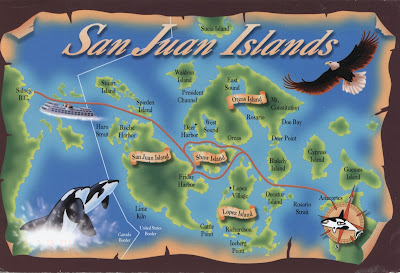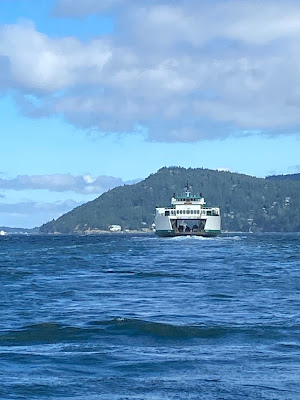 |
Steamer Reliance
Kitsap County Transportation Company
Verso dated 17 April 1913.
During this time she was busily employed
in transporting logging machinery, horses,
and wagons from Seattle.
On the summer schedule, Capt. Charles Wallace
provided two round trips per day to Harper,
Colby, and Manchester, five days per week and
three trips on weekends. Just before her busy season,
she went into drydock for her annual overhaul.
Click image to enlarge.
Original photo from the archives of the
Saltwater People Historical Society© |
The Reliance Pitches and Rolls into Puget Sound, 1900
As told to Captain Torger "Tom" Birkland
by Captain Chris Moe.
"In 1889, the steamboat service to Poulsbo was not satisfactory. We felt that a bigger, faster boat should be on the run to take care of the fast increasing population. The steamer Dauntless on the Seattle-Tacoma via Vashon Island run was available, so we bought her for the home run by the east side of Bainbridge Island, taking in several way ports. We soon bought out the opposition boat, and the business increased to a point where the Dauntless became too small.
The Oregon Railway & Navigation Co., of Portland, had a fast and larger boat for sale. This boat was built in 1899 for the upper Columbia River run between Portland and the Dalles and was very speedy with a larger capacity for passengers and freight. Andrew and I went to Portland to look at this vessel, and after a thorough inspection found her to be practically new and in excellent condition. We returned home with a favorable report so father went to Portland and prepared to close the deal, which he did after first telling the OR & N the vessel was of flimsy construction, and not worth the price which they asked. He then made an offer of several thousands of dollars less, which was finally accepted and we made plans for bringing our new ship home.
I immediately went to Portland to supervise the job of preparing the little boat for the deep-sea voyage from the Columbia River to Puget Sound. The deckhouse was braced and re-enforced, the windows boarded up, the smokestack well-secured and everything lashed down.
We departed from Portland on 8 September 1900, with a crew of two sailors, two firemen, two engineers, two mates, and Captain George Tyler in command. We arrived at Astoria on the evening of the 9th. For the next two days, the bar was too rough to cross, and this delay presented an opportunity for some of our thirsty crew members to go uptown, come back drunk and demand more money for liquor. This caused no end of trouble. Instead of money, we gave them meal tickets, which they pawned for liquor. We finally managed to get them all aboard at one time, and cast off the lines to get away. On September 12th, at 5:00 we crossed the bar. The first few violent rolls broke the water lines. Losing all our freshwater, it was necessary to use saltwater in the boilers. The seas broke over the superstructure and flooded the engine room to a point where there was danger of it putting out the fires. The engineer was worried about the saltwater in the boilers but there was nothing we could do about it. The brave little steamer rolled, twisted, and pitched along the Oregon and Washington coast until Cape Flattery was reached on the morning of September 13th. What a welcome sight was the faint flash of the Tatoosh Island light when first sighted by the anxious mariners that morning at 4:00 AM.
With the boilers full of saltwater, progress was slow. It was noon before we finally rounded Cape Flattery and set our course up Juan de Fuca Strait. The chief engineer said he would try to make Clallam, hoping that there we could replenish our completely exhausted water supply. If not, the boat would have to stay at the dock!
Forest fires were raging and every man and boy in this community were out firefighting, and no one could be found to haul water to the dock for us. And now, to add to our already troubled minds, the heavy ground swell rolling in from the ocean kept the vessel surging on the lines to a point of eventually parting or pulling out the bitts.
The following day on her regular run from Neah Bay and way stops to Seattle, the steamer Alice Gertrude came in. I boarded the vessel for a ride to Port Angeles to get a tug to tow our disabled ship to that city. The tugboat Katy was available and we departed for Clallam. All went well until a few miles west of Ediz Hook when she broke down. After temporary repairs, the captain hauled around and went back to the Port Angeles dock and tied her up. That was the end of that.
What to do next? Constantly worrying about our boat, I boarded the next regular steamer for Clallam. There was not much else I could do as all means of communication with Seattle were broken down and word could not be sent through for a tug from there. On our arrival at Clallam we found the boat missing. I thought "the worst has happened--the lines must have parted and she's gone adrift." The man in charge of the dock had no idea of what had happened; all he knew was that a steamboat had disappeared. I could do nothing but remain aboard for the long run to Neah Bay and back to Port Angeles. It was a disagreeable trip. The smoke in the straits hung over the water like a dense fog and being uneasy and restless, I was pacing the deck with the man on watch most of the way.
But a pleasant surprise was in store! About the first thing I did see through the haze was the Reliance snugly tied up at the dock, with steam up and ready to go. I learned that the tug Tyee had stopped in at Clallam and our captain asked for a tow into Port Angeles. All this took place during the night, and in the dense smoke and fog, our ships passed unnoticed.
But we were on our way home at last. During all this time since we left Astoria I had not had a wink of sleep, so no wonder when nearing our destination, I fell asleep. After what seemed only a few minutes I was wakened and told the boat was hard aground on some unknown beach and the tide was ebbing. The captain was going around in a drunken stupor and had no idea of where we were, so now it was all up to me. Realizing the danger of the vessel taking an out-board list and turning on its side and filling with water, I ordered the shore side lifeboats lowered and filled with water to give the vessel an inboard list. Then we waited for the tide to turn.
With the captain sound asleep in his bunk, we once again got underway. As nearly as I could figure we were somewhere between Jefferson Head and Agate Pass, and by the echoes, we navigated the Reliance home to Poulsbo with no more mishaps arriving home on a Sunday morning just in time for church--where I fell asleep, and that's the truth."
Courtesy of The Sea Chest membership journal,
Vol. 1, No. 1, September 1967
Puget Sound Maritime Society, Seattle, WA.
~~~~~~~~~~~~~~~~~~~~~~~~~~~~~~~~~~~~~~~~~~
Sometimes, when known, we list some of the "other" officers and crew of a featured vessel, not part of the story presented, but part of the past life of the vessel.
From Roland Carey's, The Sound of Steamers; pages 102-109, Seattle; 1965, we learn of Chief Roy H. Kimmel. (Abridged.)
"Many a young man, during the bygone era of steamboating, earned his first wages working on a Sound steamer. Those lessons in resourcefulness, loyalty, and reliability were invaluable in later life and some men carried skills from Puget Sound to the wide waters of the world.
Such a man was Roy H. Kimmel (born on Vashon Island, 1891), who began steamboating at the age of 18, as fireman for Robert McDowell. Next, he worked for the Vashon Navigation Co., on several of their vessels, including the steamer RELIANCE, featured in the above writing by Capt. Birkland. Kimmel became Chief Engineer in 1918 on the RELIANCE. In 1922 he returned to Inland Transportation Co as chief engineer on the CALISTA. He had been back on the CALISTA but one day, on 27 July 1922, for her Seattle-Whidbey Island route. The fog became thick at the north entrance to Seattle harbor. On this day the CALISTA in command of Capt. Barlett Lovejoy was hit by the big Japanese liner HAWAII MARU. Chief Kimmel and all crew and passengers were saved before the CALISTA went to the bottom 28 minutes later.
During WW II, Kimmel carried his skill into the Pacific. In Nov. 1943, he was first assistant engineer on the Liberty Ship JOHN P. GAINES when the vessel with crew, Navy gun crew, and Army passengers, were battered with their ship broken in two by a hurricane 100 miles off the Alaskan coast. Everyone was rescued.
 |
Liberty Ship John Burke Built by Oregon Shipbuilding Co. Launched at Portland, 15 Dec. 1942. 422.10' x 57.0' x 27.10' Two oil-fired boilers, triple expansion, reciprocating steam engine, single screw. In this photo the John Burke is NW of Vancouver Island, B.C, May 1944. She was lost Philippines, 28 Dec. 1944 Complement: 40 crew & 28 Armed Guard.
|
One year later chief engineer Kimmel was on the Liberty Ship JOHN BURKE, carrying ammunition to troops fighting in the Philippine Island of Mindoro. The ship, commanded by Capt. Herbert A. Falk, was part of a big supply convoy coming up from Leyte Gulf with manpower and material for airfield construction. The convoy was screened by nine destroyers. Japanese air forces attacked at dawn, morning, noon, dusk, and night. The pilots were well briefed, for they knew which ships in the convoy carried vital cargo. Kamikaze fighters made a direct hit on the BURKE and the explosive charge in the fighter mingled with the explosives in the ship's hold. A tremendous flash was followed by an enormous white cloud covering an area of several thousand yards. When the cloud cleared, it was as though the BURKE had never been. As she sank to the depths of Mindanao Sea, other ships in the vicinity felt a severe underwater explosion, the last defiant growl of a vessel that went down with all hands."
The BURKE had departed Seattle in late 1944 for Guam where she spent several days loading munitions for the invasion force on the island of Mindoro. BURKE then departed with the 100-ship "Uncle Plus 13" convoy, bound for Leyte in the Philippines. The JOHN BURKE fragments lie 1,500-ft below the surface in the strait between Negros, Siquijor Islands and Dapitan, Mindanao, Philippines.

































